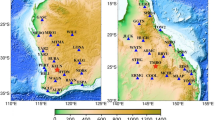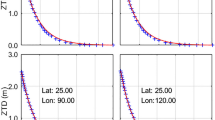Abstract
Iran enjoys a variety of climatological conditions. Moreover, numerical weather prediction (NWP) models are not assimilated with the meteorological data in Iran, the country suffering from poor spatial and temporal resolution of radiosonde measurements. These facts make modeling of troposphere impossible using the measurements and NWP. On the other hand, the global positioning system (GPS) has been emerged as a valuable tool for modeling and remote sensing of Earth’s atmosphere. This research is the first attempt to address the tropospheric wet refractivity modeling by GPS measurements in Iran. Changes of topography in the study area are taken into account. As a leading work, virtual reference stations (VRS) are used to fix the rank deficiency of the problem. The model space resolution matrix is used to achieve the optimum spatial resolution of the tomographic model and the optimum number of VRS stations. The accuracy of the developed model (KNTU1) is investigated by deploying radiosonde measurements.








Similar content being viewed by others
Notes
Day Of Year.
References
Al-Shaery A, Lim S, Rizos C (2011) Investigation of different interpolation models used in network-RTK for the virtual reference station technique. J Glob Position Syst 10:136–148. doi:10.5081/jgps.10.2.136
Aster R, Borchers B, Thurber C (2005) Parameter estimation and inverse problems, vol 90. Elsevier Academic Press, USA
Becker M, Bruyninx C, Fernandez R (2002) Processing and Submission Guidelines for GPS Solutions to be Integrated to a WEGENER Data Base,Proceedings of WEGENER 2002. Athens, Greece, University of Athens, Jun 12-14
Bender M, Raabe A (2007) Preconditions to ground based GPS water vapour tomography. Ann Geophys 25(8):1727–1734
Bender M et al (2009) Estimates of the information provided by GPS slant data observed in Germany regarding tomographic applications. J Geophys Res. doi:10.1029/2008JD011008
Bender M et al (2011) Development of a GNSS water vapour tomography system using algebraic reconstruction techniques. Adv Space Res 47:1704–1720. doi:10.1016/j.asr.2010.05.034
Bertero M, Boccacci P (1998) Introduction to inverse problem in imaging. Institute of Physics, London
Bevis M, Businger S, Herring T, Rocken C, RA A, Ware RH (1992) GPS meteorology: remote sensing of atmospheric water vapor using the global positioning system. J Geophys Res 97(D14):15787–15801
Böhm J, Niell A, Tregoning P, Schuh H (2006) Global mapping function (GMF): a new empirical mapping function based on numerical weather model data. Geophys Res Lett. doi:10.1029/2005GL02554
Bosy J, Rohm W, Sierny J (2010) The concept of the near real time atmosphere model based on the GNSS and the meteorological data from the ASG-EUPOS reference stations. Acta Geodyn Geomater 7:253–261
Brenot H et al (2014) A GPS network for tropospheric tomography in the framework of the Mediterranean hydrometeorological observatory Cévennes-Vivarais (southeastern France). Atmos Meas Tech 7:553–578. doi:10.5194/amt-7-553-2014
Cai G, Chen BM, Lee TH (2011) Unmanned rotorcraft systems. Springer, New York
Dach R, Hugentobler U, Fridez P, Meindl M (2007) Bernese GPS Software Version 5.0. Astronomical Institute, University of Bern, Bern
Dai L, Han S, Wang J, Rizos C (2001) A study of GPS/GLONASS multiple reference station techniques for precise real-time carrier phase–based positioning. In: 14th Internationl Technical Meeting of the Satellite Division of the US Institute of Navigation, Salt Lake City, Utah, 11–14 September, pp 392–403
Davis JL, Herring TA, Shapiro II, Rogers EE, Elgered G (1985) Geodesy by radio interferometry: effects of atmospheric modeling errors onestimates of baseline length. Radio Sci 20(6):1593–1607
De Brito Mendes V (1999) Modeling the neutral-atmosphere propagation delayin radiometric space techniques. University of New Brunswick, Fredericton
Elfving T, Nikazad T, Hansen PC (2010) Semi-convergence and relaxation parameters for a class of sirt algorithms. Electron Trans Numer Anal 37:321–336
Emardson TR, Elgered G, Johansson JM (1998) Three months of continuous monitoring of atmospheric water vapor with a network of Global Positioning System receivers. J Geophys Res 103:1807–1820
Erhu Wei E, Chai H, An Z (2006) VRS virtual observations generation algorithm. J Global Position Syst 1–2:76–81
Euler HJ, Keenan CR, Zebhauser BE, Wübbena G (2001) Study of a simplified approach in utilizing information from permanent reference station arrays. Paper presented at the Proceedings 14th International Technical Meeting of the Satellite Division of the Institute of Navigation, Salt Lake City, USA, ION GPS-2001, September 11–14
Flores A, Ruffini G, Rius A (2000) 4D tropospheric tomography using gps slant wet delays. Ann Geophys 18(2):223–234. doi:10.1007/s00585-000-0223-7
Foelsche U, Kirchengast G (2001) Tropospheric water vapor imaging by combination of ground-based and space born GNSS sounding data. J Geophys Res 106(D21):27221–27231
Fotopoulos G, Cannon ME (2001) An overview of multi-reference station methods for Cm-level positioning. GPS solutions 4:1–10
Golub GH, Matt U (1997) Generalized cross-validation for large scale problems. J Comput Graph Stat 6(1):1–34. doi:10.1080/10618600.1997.10474725
Grewal MS, Weill RL, Andrews AP (2007) Global positioning systems, inertial navigation, and integration. Wiley, New York
Guerova G (2003) Application of GPS derived water vapour for numerical weather prediction in Switzerland. University of Bern, Bern
Gurtner W (1994) RINEX: The reciever-independent exchange format GPS World, Las Cruces: 48–52
Hansen PC (1998) Rank-deficient and discrete ILL-posed problems: numerical aspect of linear inversion, Philadelphia
Hirahara K (2000) Local GPS tropospheric tomography. Earth planet space 52(11):935–939
Hoyle VA (2005) Data assimilation for 4-D wet refractivity modelling in a regional GPS network. Calgary, Alberta
Hu GR, Khoo VHS, Goh PC, Law CL (2002) Internet-based GPS VRS RTK positioning with a multiple reference station network. J Global Position Syst 1:113–120
Jarlemark POJ, Johansson JM, Emardson TR (1998) Wet delay variability calculated from radiometric measurements and its role in space geodetic parameter estimation. Radio Sci 33:719–730
Kleijier F (2004) Troposphere modeling and filtering for precise GPS leveling. Delft, The Netherlands
Landweber L (1951) An iteration formula for Fredholm integral equations of the first kind. Am J Math 73:615–624
Langley R (1998b) Propagation of the GPS Signals, Chap 3, In: Teunissen, Kleusberg, pp 111–149
Lutz SM (2008) High-resolution GPS tomography in view of hydrological hazard assessment. ETH Zurich, Switzerland
Manning T, Zhang K, Rohm W, Choy S, Hurter F (2012) Detecting severe weather using GPS tomography: an australian case study. J Global Position Syst 11:58–70. doi:10.5081/jgps.11.1.58
Marel H-v-d (1998) Virtual GPS reference stations in the Netherlands. In: Paper presented at the Proc 11th International Technical Meeting of the Satellite Division of the US Institute of Navigation, ION GPS-98, Nashville, TN, September 15–18
Menke W (2012) Geophysical data analysis: discrete inverse theory MATLAB Edition. doi:10.1016/B978-0-12-397160-9.00001-1
Mervart L (1995) Ambiguity resolution techniques in geodetic and geodynamic applications of global positioning system. University of Bern, Bern
Nikazad T (2007) The use of land weber algorithm in image reconstruction. Linköpings University, Linköpings
Nilsson T, Gradinarsky L (2006) Water vapor tomography using GPS phase observations: simulation results. IEEE Trans Geosci Remote Sens 44:2927–2941
Odijk D (2002) Fast precise GPS positioning in the presence of ionospheric delays. University of Delft, The Netherlands
Raquet J, Lachapelle G (2001) Efficient precision positioning: RTK positioning with multiple reference stations. GPS World 12(48):53
Rasmussen JM (2001) Compact linear operators and Krylov subspace methods. Technical University Denmark, Denmark
Rizos C, Han S, Chen HY (2000a) Regional-Scale multiple reference stations for carrier phase-based GPS positioning a correction generation algorithm Earth. Planet Space 52(10):795–800
Rizos C, Han S, Chen HY (2000b) Regional-scale multiple reference stations for carrier phase-based GPS positioning a correction generation algorithm Earth. Planet Space 52:795–800
Rohm W, Bosy J (2009) Local tomography troposphere model over mountains area. Atmos Res 93(4):777–783. doi:10.1016/j.atmosres.2009.03.013
Rohm W, Bosy J (2011) The verification of GNSS tropospheric tomography model in a mountainous area. Adv Space Res 47:1721–1730. doi:10.1016/j.asr.2010.04.017
Rothacher M, Schaer S, Beutler G, Schlüter W, Hase HO (1996) Phase center variations of GPS antennas derived from GPS observations of specially designed calibration campaigns supplement to EOS, American Geophysical Union, 1996 Springer Meeting, May 20–24 77:G11A-16
Rothacher M, Springer TA, Schaer S, Beutler G (1998) Processing strategies for regional GPS networks. In: Brunner Fk (ed) International Association of Geodesy Symposia, vol 118. Advances in Positioning and Reference Frames, Springer, Berlin Heidelberg, pp 93–100. doi:10.1007/978-3-662-03714-0_14
Saastamoinen J (1973) Contributions to the theory of atmospheric refraction. Part II: refraction corrections in satellite geodesy. Bull Geod 107:13–34
Schaer S (1999) Mapping and predicting the earth’s Ionosphere using the global positioning system. University of Bern, Bern
Schüler T (2001) On ground-based GPS tropospheric delay estimation
Shangguan M, Bender M, Wickert J, Raabe A (2011) Validation of GNSS water vapour tomography with radiosonde data. In: Geodätische Woche Nürnberg
Shangguan M, Bender M, Ramatschi M, Dick G, Wickert J, Raabe A, Gales R (2013) GPS tomography: validation of reconstructed 3-D humidity fiDiescludsssions with radiosonde profiles. Ann Geophys 31:1491–1505
Spilker J (1996d) Tropospheric Effects on GPS. In: Parkinson Spilker (eds) 1,Chap.13:517-546
Vedel H, Huang XY (2004) Impact of ground based GPS data on numerical weather prediction. J Meteorol Soc Jpn 82(1B):459–472
Vollath U, Buecherl A, Landau H, Pagels C, Wager B (2000) Multi-base RTK positioning using virtual reference stations.In: Paper presented at the Proceedings 13th International Technical Meeting of the Satellite Division of the US Institute of Navigation, ION GPS-2000, Salt Lake City, September, 19–22
Wanninger L (1997) Real-time differential GPS-error modeling in regional reference station networks. Paper presented at the Proceedings of the IAG scientific assembly, Rio de Janeiro, Sep
Watkins DS (2002) Fundamentals of matrix computations. Wiley, USA
Wu L (2003) A parameter choice method for Tikhonov regularization ENTA Kent State University 6:22
Wu S (2009) Performance of regional atmospheric error models for NRTK in GPSnet and the implementation of a NRTK system. RMIT University, Australia
Xia P, Cai C, Liu Z (2013) GNSS troposphere tomography based on two-step reconstructions using GPS observations and COSMIC profiles. Annales Geophysicae 31:1805–1815. doi:10.5194/angeo-31-1805-2013
de Haan S, Barlag S, Klein Baltink H, Debie F, van der Marel H (2004) Synergetic use of GPS water vapor and Meteosat images for synoptic weather forecasting. J Appl Meteorol 43:514–518
Zhang K, Roberts C Network-based real-time kinematic positioning system: current development in Australia. In: Geoinformatics and Surveying Conference, Malaysia, 7 Apr 2003
Zhang S, Lim S, Rizos C, Guo J Atmospheric decomposition for VRS based network-RTK system. In: 22nd International Technical Meeting of the Satellite Division of the US, Institution of Navigation, Savannah, Georgia, 22–25 September 2009, pp 2707–2716
Acknowledgments
During this research, Mr. Akbar who is a member of the meteorological organization of Iran, kindly provided us valuable remarks. His cooperation is appreciated here. The meteorological organization of Iran provided the radiosonde profiles with dense pressure levels of the Tabriz station and the observation files of Synoptic stations in the northwestern part of the country for this research. This collaboration is also appreciated here. We are grateful to the National Cartographic Center (NCC) of Iran for providing the observation files of the Azerbaijan sub-network of the Iranian Permanent GPS Network too.
Author information
Authors and Affiliations
Corresponding author
Additional information
Responsible editor: M. Kaplan.
Rights and permissions
About this article
Cite this article
Adavi, Z., Mashhadi-Hossainali, M. 4D tomographic reconstruction of the tropospheric wet refractivity using the concept of virtual reference station, case study: northwest of Iran. Meteorol Atmos Phys 126, 193–205 (2014). https://doi.org/10.1007/s00703-014-0342-4
Received:
Accepted:
Published:
Issue Date:
DOI: https://doi.org/10.1007/s00703-014-0342-4




